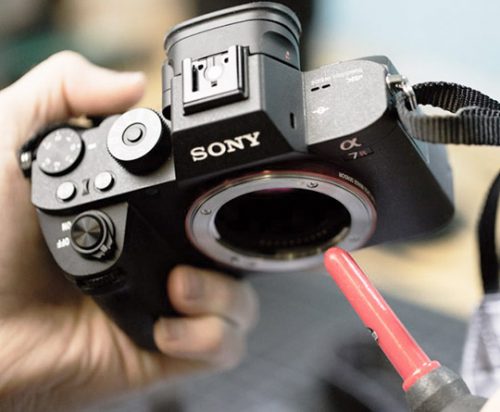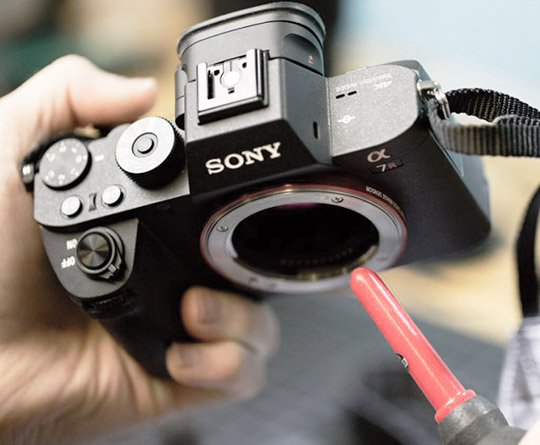
Talk to ten professionals and you may get ten different answers on the question of cleaning the camera sensor. But most agree that you want to err on the side of inaction. Cleaning the camera sensor too often or too aggressively is a very bad idea.
When Should You Consider Cleaning The Camera Sensor?
Most people wait till they see dust artifacts in the image. You can shoot wide open with a dusty sensor and never see it. But if you often shoot shoot outdoors stopped down at f/11 and f/16, even a small amount of dust will show. Here is a simple test for dust. Take the camera outside and point it at the sky with a low ISO setting. Your camera will stop down to f16 or so and you will easily see how much dust is on your sensor.
Those who often change lenses are more likely to have a dust issue.
Use a sensor loupe to determine if cleaning the camera sensor is even necessary. A Sensor Loupe will reveal the truth about whether there is dust or spots of liquid which look like dust. Many people skip this step, but at Lensrentals.com, a camera rental house which cleans hundreds sensors, the practice is to always use a loupe before cleaning a camera sensor.
If it’s time for cleaning the sensor, the first step should be to use the camera’s sensor cleaner if the camera is so equipped. Many recent DSLRs and MILCs (mirrorless interchangeable lens camera) have self-cleaning sensors that vibrate at ultrasonic speeds when the camera is turned on or off.
If these fail to sufficiently clean the sensor, use a hand blower like Giottos rocket blower which is available for about ten dollars. But please never use canned air like Dust-Off. The propellant in such products can leave a residue on the sensor. The residue may need to be professionally removed and that will cost you.
The Risk Of Damaging The Sensor
It’s very unlikely that you will damage your sensor. Lensrental believes they may scratch a sensor once in every 750 cleanings. Just another reason not to clean more than is really necessary. And the risk is much smaller if you are only using a handheld blower and not touching the sensor.
Before You Start
- Make sure the battery is charged.
- If your camera has an in-body image stabilization mode
- Clean the camera body first.
- Work in a clean area.
If it dies while you’re working in the sensor chamber, the mirror will slap down which could result in an expensive repair. Beware also of accidentally bumping the card door enough to open it.
that allows demobilization, be sure this is activated before cleaning the sensor. If it tried to stabilize when you are cleaning, you could damage the stabilization mechanism.
Any dust on the outside could end up on the sensor.
You’ll want to remove all the dust you can from the inside of the camera. Blow any dust out of the mirror box of a DSLR before raising the mirror and opening the shutter to expose the sensor. The reason is that the sensor has an electrostatic charge when the camera is on in normal mode. That attracts dust like a magnet. There is no charge during the sensor cleaning mode.
For the first few blasts of air, hold the camera up with the mount facing down. This should keep flying dust away from the sensor chamber. In the vast majority of cases, this blowing will be all that’s required.
The next step, if necessary, is the use of a LensPen MicroPro Lens Cleaner.
When is Wet Cleaning Indicated
If there are tiny liquid spots or dried residue is present on the sensor, it’s time for wet cleaning. This is a simple procedure that requires a sensor swab and cleaning solution.
Apply the recommended amount of solution, then using an easy touch, glide the swab from one side to the other. Check your progress with the sensor loupe after each pass. Don’t re-use the swabs. Replacing a sensor is a lot more expensive than replacing a swab.
Don’t Over Do Cleaning The Camera Sensor
If you shoot exteriors at f/11 or f/16, you need a spotless sensor. Otherwise shooting interiors at f/5.6 and wider will not require a perfectly clean sensor. Every once in a while take a still at f/16 and see what you sensor looks like.







Recent Comments